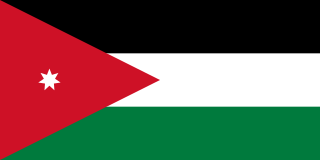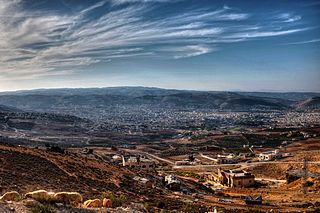
The history of Jordan refers to the history of the Hashemite Kingdom of Jordan and the background period of the Emirate of Transjordan under British protectorate as well as the general history of the region of Transjordan.

The Emirate of Transjordan, officially known as the Amirate of Trans-Jordan, was a British protectorate established on 11 April 1921, which remained as such until achieving formal independence as the Kingdom of Jordan in 1946.

Al-Karak, in English sources often simply Karak, is a city in Jordan known for its medieval castle, the Kerak Castle. The castle is one of the three largest castles in the region, the other two being in Syria. Al-Karak is the capital city of the Karak Governorate.

Al-Salt, also known as Salt, is an ancient trading city and administrative centre in west-central Jordan. It is on the old main highway leading from Amman to Jerusalem. Situated in the Balqa highland, about 790–1,100 metres above sea level, the city is built in the crook of three hills, close to the Jordan Valley. One of the three hills, Jabal al-Qal'a, is the site of a 13th-century ruined fortress. It is the capital of Balqa Governorate of Jordan.

Al-Jizah, historically known as Ziza or Zizia, is a town in northwestern Jordan. It is the 22nd district of the Amman Governorate. During the medieval period it served as a waystation for pilgrims en route to the Hajj in Mecca. This function ceased in the 17th century, though a fort remained there, however was later reinstated when the Al-Fayez clan of the Bani Sakher gained the rights for Hajj protection in the 18th century. The region has been one of the Al-Fayez strongholds ever since.
The Tuqan clan is a prominent Palestinian and Jordanian political and business family. During the Ottoman era, they dominated the political and socio-economic spheres in Nablus and extended their influence to al-Salt. During that era, they were the only household that came close to establishing centralized rule over Jabal Nablus. Over the course of the 18th and 19th centuries the Tuqan family held the title of mutasallim of Nablus longer than any other local family.
Sheikh Attallah Suheimat or Attlallah Pasha Suheimat was a Jordanian leader, politician, and a statesperson. Born in the historic city of Al Karak, south of Jordan. He was the son of Sheikh Sulieman effendi Suheimat who was a national leader and a Member of the first municipal council of the city of Karak during the reign of the Ottoman Empire in the 1890s. Sheikh Attallah Suheimat was the head of the Ghassanids tribes in Jordan, and a famous leader during different time periods in the region: Ottoman Syria, Transjordan, and later the Hashemite Kingdom of Jordan. He held several senior positions including the President of the Al-Haqqania Court in the Ottoman Empire and President of the Court of First Instance in The "National Government of Moab". He participated in the development of the National Charter in 1928, and in 1929 was a member of the first Legislative Council in the Emirate of Transjordan representing Al Karak and Ma'an. Sheikh Suheimat was the Director of the General Intelligence in the government of King Faisal I of Syria.

The Hauran Druze Rebellion was a violent Druze uprising against Ottoman authority in the Syrian province, which erupted in 1909. The rebellion was led by the al-Atrash family, in an aim to gain independence, but ended in brutal suppression of the Druze, significant depopulation of the Hauran region and execution of the Druze leaders.

Mustafa Wahbi Tal, also known by his pen name Arar, was a Jordanian poet, writer, teacher and civil servant, widely regarded as Jordan's most prominent poet and among the best-known Jordanian poets among Arab readers.
Husayn Pasha ibn Makki served as the Ottoman wali of Damascus (1757) and Marash (1762), and the sanjak-bey of his native Gaza (1763–1765).
The 1757 Hajj caravan raid was the plunder and massacre of the Hajj caravan of 1757 on its return to Damascus from Mecca by Bedouin tribesmen. The caravan was under the protection of an Ottoman force led by the Wali of Damascus, Husayn Pasha, and his deputy Musa Pasha, while the Bedouin were led by Qa'dan al-Fayez of the Bani Sakher tribe. An estimated 20,000 pilgrims were either killed or died of hunger or thirst as a result of the raid.

Jordanian nationalism is a nationalistic ideology that considers the Jordanian people a separate nation and strives to maintain Jordan as an independent nation-state. It emerged as one of three nationalist currents in the 1920s, and was opposed to both Palestinian nationalism present in the region, as well as the Hashemite Arab nationalism promoted by Abdullah I, the first ruler of the Emirate of Transjordan.

The Mutasarrifate of Karak, also known as the Sanjak of Karak, was an Ottoman district with special administrative status established in 1895, located in modern-day Jordan. The city of Karak was the district's capital. It had a population of 72,562 in 1914.

Mehmed Rashid Pasha was an Ottoman statesman who served as the vali (governor) of Syria Vilayet in 1866–1871 and as minister of foreign affairs of the Ottoman government in 1873–1874 and 1875 until his death. Rashid Pasha was raised in Egypt where his father was an aide of the governor Muhammad Ali and was educated in Paris before joining government service in Istanbul in 1851. There he became a protege of the grand vizier Ali Pasha, a key figure in the empire-wide Tanzimat reforms. After the latter was reappointed grand vizier in 1866, Rashid Pasha was appointed governor of the Damascus-centered Syria Vilayet which extended from Tripoli and Hama in the north to Palestine and Transjordan in the south.

Siege of Al-Karak was a 17-day siege imposed by Ibrahim Pasha of Egypt on the Transjordanian town of Al-Karak in 1834. The Pasha laid the siege on the town in pursuit of Qasim al-Ahmad, the leader of the Peasants' revolt in Palestine, who had fled from Nablus to take shelter in Al-Karak.

The Karak revolt was an uprising against Ottoman authority in the Transjordanian town of Al-Karak, which erupted on 4 December 1910. The revolt came after Sami Pasha, the governor of Damascus, wanted to apply the same measures of conscription, taxation, and disarmament to the inhabitants of Al-Karak that previously provoked the Hauran Druze Rebellion.

Ash-Sharāt or Ash-Sharāh (Arabic: ٱلشَّرَاة, also known as Bilād ash-Sharāt or Jibāl ash-Sharāt, is a highland region in modern-day southern Jordan and northwestern Saudi Arabia. It was formerly a sub-district in Bilad al-Sham during the 7th–11th centuries CE.

The Balqa, known colloquially as the Balga, is a geographic region in central Jordan generally defined as the highlands east of the Jordan Valley in between the Zarqa River to the north and the Wadi Mujib gorge to the south.

Establishment of the Emirate of Transjordan refers to the government that was set up in Transjordan on 11 April 1921, following a brief interregnum period.

Circassians in Jordan are descendants of Circassian refugees who arrived in Jordan in the late 19th century after the Circassian genocide in the 1860s and the Russo-Turkish War (1877–1878). They settled in Jordan, then a part of Ottoman Syria, in and around Amman and Jerash. Circassians are credited with founding modern Amman as the city had been previously abandoned.



















